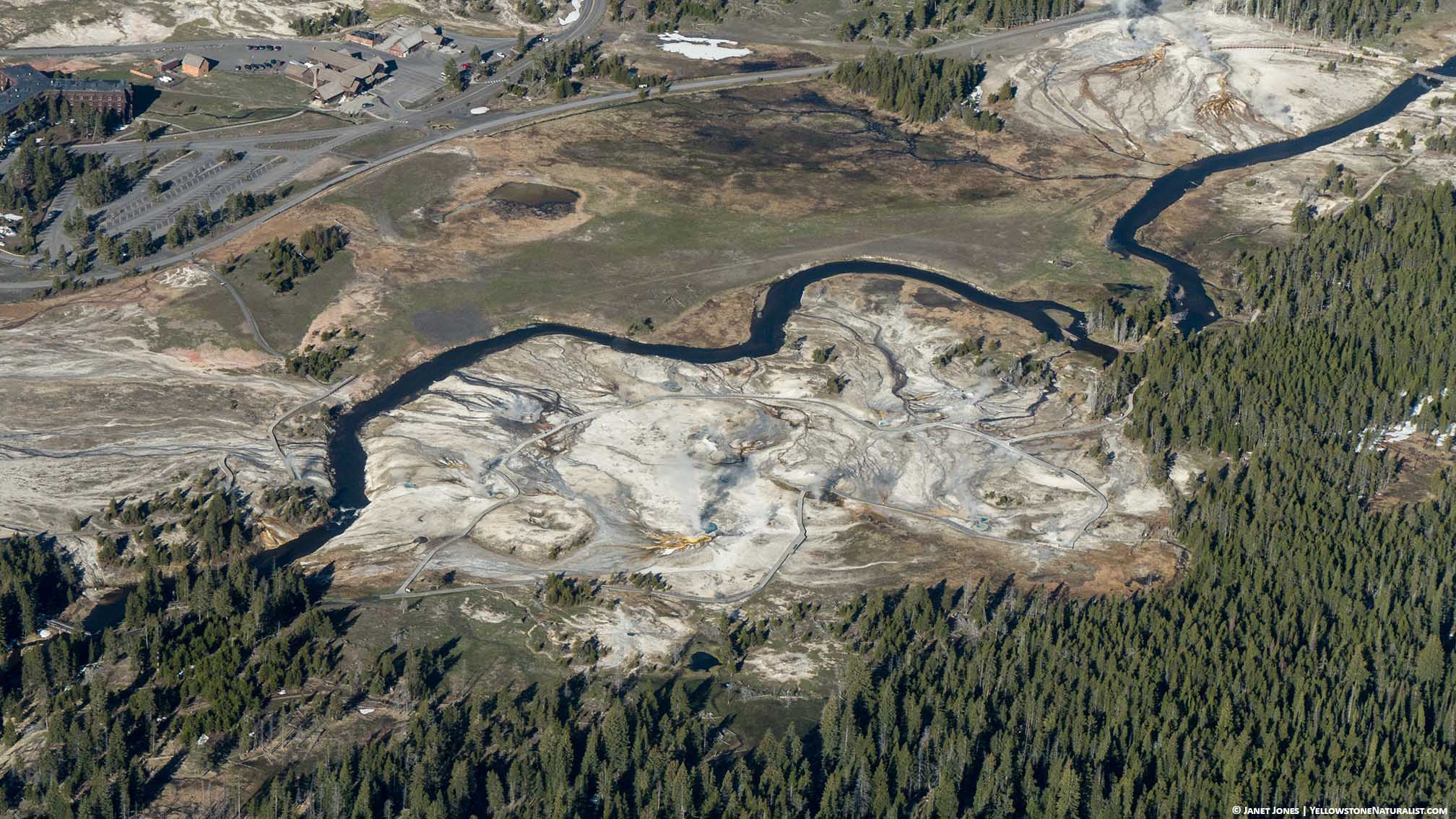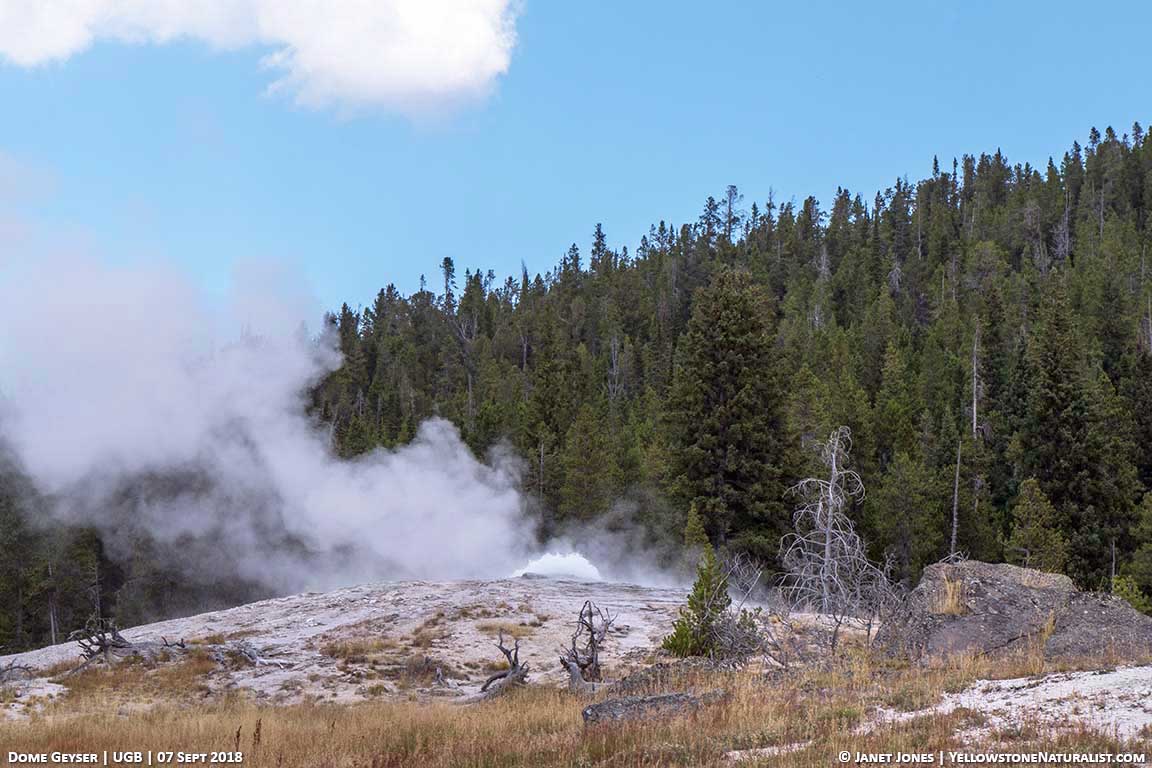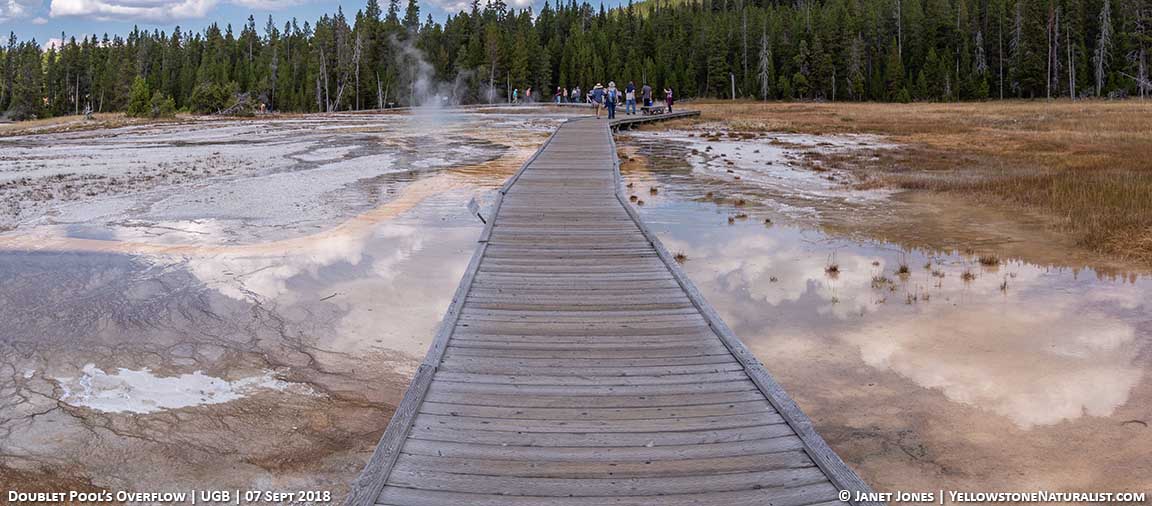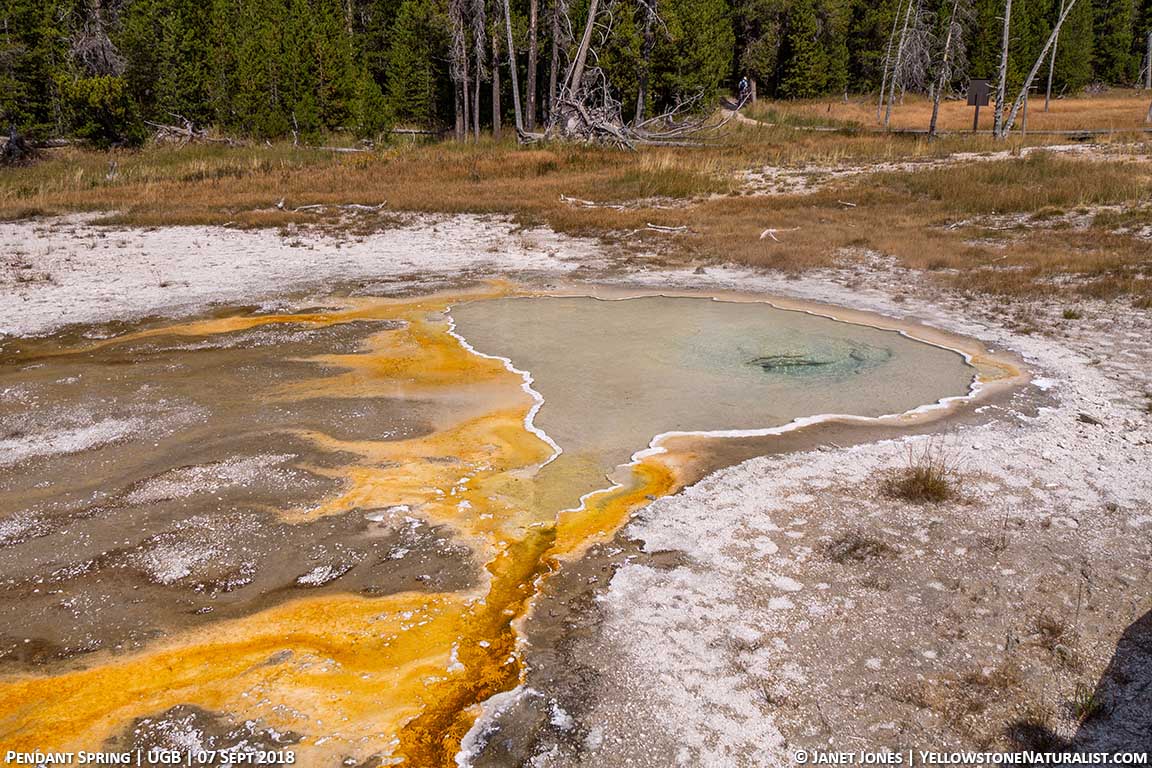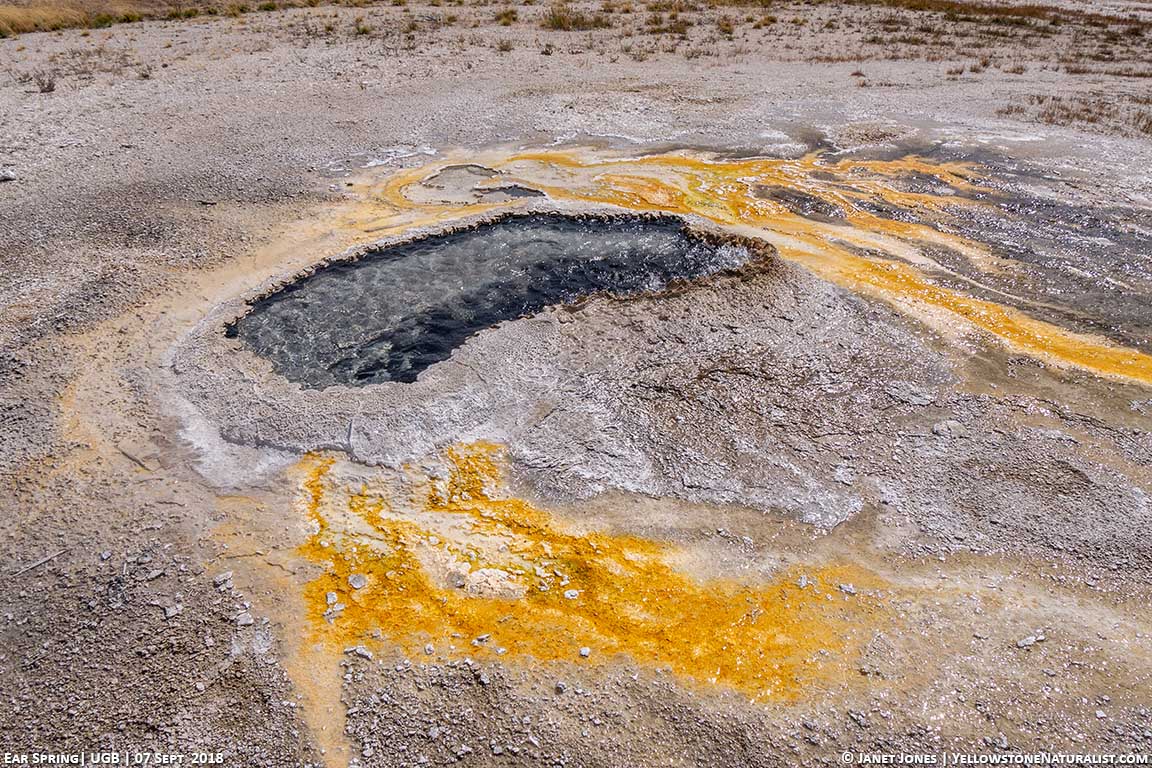Unusual Activity on Geyser Hill (Part 1)
It’s often in the fall that we see some interesting changes happen in the geyser basins. This September saw a rather large change on Geyser Hill (near Old Faithful) that’s resulted in some unprecedented behavior (as far as records show). In this post I’ll do my best to bring you up to speed on what I know. I’ll go through what changes have happened as well as my personal thoughts on this. If you have questions, please ask in the comments! I’ve held off writing this post because there’s so very much to say, and yet I want to make sure everyone is up to speed.
WHERE IS GEYSER HILL
To start with the basics, Geyser Hill is in Yellowstone’s Upper Geyser Basin, located not far from Old Faithful. Beehive and Lion Geyser are often seen in eruption “behind” Old Faithful. Geyser Hill is a small area packed with geysers, many of them large.
To reach Geyser Hill, walk around Old Faithful along the boardwalk until you reach the path that descends through the trees toward the river. You then cross the bridge and head up to Geyser Hill.
UNUSUAL ACTIVITY ON GEYSER HILL
On 15 Sept 2018, thanks to the live streaming webcam (courtesy of Canon’s donation to Yellowstone Forever’s Eyes on Yellowstone program), the webcam operator at the time, Dave Monteith, spotted a rare eruption of Ear Spring. As information came in from those on the ground there, I knew I had to get in the next day. This was unusual. Most of the hot springs in that area of Geyser Hill were behaving differently. North Goggles Geyser was erupting every 10 minutes or so! Pendant Spring, Doublet Pool and more were active. But I’m getting ahead of myself again. Let me go through a few terms here.
Is this a disturbance?
Generally speaking “disturbance” is a term usually used for Norris Geyser Basin when hot springs and geysers not normally active erupt. This is because there are two water reservoir chambers under Norris Geyser Basin. We know this because of research done on the chemical analysis of the water when a disturbance is underway and when there isn’t a disturbance. When the lower water chamber is involved in many smaller thermal features, a disturbance is underway. At Norris, Steamboat Geyser and Ledge Geyser are thought to tap into this lower chamber as well when active.
So can we use the term ‘disturbance’ to accurately describe the behavior seen on Geyser Hill?
Maybe – it also could be correctly termed as an energy surge, which is what I’m leaning toward at this point, though I don’t rule out the possibility of a deeper water chamber coming into play here. The thermal energy in the geyser basins seems to shift and move. No research that I know of has directly involved this aspect (if you know of any, I would be very interested!), but it certainly does seem to shift and change.
Dr. Bob Fournier did research on the chemical analysis of the hot springs and geysers throughout the upper geyser basin. As he explained in the 2013 Thermal Conference in Yellowstone, the Upper Geyser Basin has two main upper water reservoir chambers and a larger one sits below the top two. The top two chambers meet at about a line from Solitary Geyser over to Grand Geyser and out to the Three Sister’s Spring area. One chamber goes out to Biscuit Basin. The other chamber goes all the way out to Lone Star.
The area of unusual activity on Geyser Hill very well may be part of this “mix” area, though to know for sure, I’d need to dig out that paper of Dr. Fournier and see how it classified this area. Also, the muddy and murky water that filled so many of the thermal features affected at least gives the same idea as a disturbance at Norris. When the lower water chamber kicks in, the water that fills the thermal features is muddy/murky. So perhaps the lower water chamber here participated in this energy surge which, by my definition of a disturbance, would qualify it as such.
Was this sudden?
Actually, no. There have been signs of change that I’ve noticed. I still need to dig through my field notes from 2017, but at some point during the summer season, I noticed what seemed like a sudden increase in water levels throughout the upper side of Geyser Hill. I also noticed times when Ear Spring (and Pendant Spring) had heated up enough to kill the microbes in the runoff channel – and had started seeping out of a side it didn’t previously. At that point, I theorized that maybe it was a connection to Giantess. But as more information came in, I changed my thoughts on that. While Ear Spring has been tied to behavior in Giantess, it also may be linked to Pendant, and others in the area. I noticed that maybe it tied into activity from North Goggles Geyser. But before I could get that idea written up, this unusual activity happened.
GEYSERS & HOT SPRINGS INVOLVED
(based on my observations and observations of others – Tara Cross, Micah Kipple, Steve Eide, Suzanne Strasser, Heinrich Koenig, and more – lucky folks that got to see the stronger eruptions the evening of the 15th)
Lion Geyser – would “roar” like before an eruption, but no water or eruption occurred. Basically, it went quiet until Sept 18.
Goggles Spring – Connected to North Goggle Geyser and others, but cannot find any reports about Goggles (yet).
North Goggle Geyser – erupting every 10 minutes. Its activity began without a long series of eruptions from Lion Geyser as has been the case in the past.
Ear Spring – 30 ft initial eruption that expelled many items from its depths.
Pendant Spring – erupting up to 6′ at first, then died down to about 2-3′ splashes
UTF Behind Pendant now referred to as “Grove Geyser” – 10′ at first, then died down to 3-4′.
Two UTFs on the way to Solitary Geyser – These two filled with murky water and the one on the “uphill” side had higher water and was splashing higher than before.
Beach Spring – once again sending out the ‘waves’ over the sinter to resemble a beach.
Aurum Geyser – began erupting every couple of hours.
UTF Next to Doublet Pool – reports of 6 ft eruptions on the 15th. By the 16th, I was seeing 2-3 foot eruptions with maybe a few a bit taller than that.
Doublet Pool – erupting in a “bubble shower” eruption (heavy boiling in small bubbles as opposed to big, vertical splashes)
A new thermal feature broke out under the boardwalk between Doublet Pool and Sponge.
Sponge Geyser – was not cycling water as far as we know – no water ever came into view.
Pump Geyser – had less water output. Whether this came all from a decrease in Pump or the bubblers down below Pump is not certain, but the microbe mat below pump dried out more.
UTF Across the boardwalk from Pump – this unnamed thermal feature (UTF) has been grumbling at least since 2017, but it began to spit small drops of water that reached above the surface of the vent.
Videos of the activity from the 16th are on my Instagram feed.
7 SEP 2018 OBSERVATIONS
On 7 Sept 2018, I was talking with another gazer about the lack of activity from Giantess. Has that energy shifted or did it just disappear? One theory is that Dome Geyser is much more active than in years past and perhaps has taken the energy from Giantess. I hadn’t walked the top side of Geyser Hill in quite some time, and figured I head up there to see what I might find. I did catch an initial eruption of Dome. Sweet.
As I walked up the thumps were in progress. The water level was high, but I wasn’t feeling the normal intensity of thumps. Instead, I wrote in my field notes (and later crossed out), “I must have arrived just as the thumps ended, yet the bubbles continue as the water level drops.” Then just a couple of minutes later, the bubbling increased and the thumps soon followed. Looking at my field notes:
1328 | Doublet Pool: Steady bubbles – “Singlet” on.
• Must have arrived just as the thumps ended – yet the bubbles continue as the water drops slightly.
1330 | Bubbling increasing.
1332 | Thumps begin.
1338 | Pause in thumps.
1339 | Restart of thumps.
1341 | End of thumps. Water level drops to the bottom of the scalloped sinter edge. Left the area.
As I walked around, I noticed the runoff channel from Beach Spring reached almost to Pendant Spring and wondered if this was new. It was different, and I chided myself for not walking this upper boardwalk trail more this summer, but I was glad I was doing it this day. I took my time and really looked at the area. Something was happening and I entered some of this into Geyser Times in case others might come up and spend more time here.
That’s when I noticed different behavior in Beach Geyser. It was showing the “Firehole flaming” effect. This is when there are larger bubbles down in the vent that just can’t make it to the surface and collapse. In the early days of the park, they wondered what this might be – and one theory was that it was a gas that was on fire. This effect can be seen best in Firehole Spring on Firehole Lake Drive in the Lower Geyser Basin. Seeing this Beach Geyser with a strong Firehole Flame effect while standing on the boardwalk was unusual. I entered this into Geyser Times as well.
As I arrived at Ear Spring, I noticed there was heavier overflow from the seep on the “left” (as you face Ear Spring) and Ear in general. It also seemed that Pendant Spring was overflowing more heavily.
All I knew was that something was afoot, but due to my schedule, all I could do was hope someone would take the notes I entered and do a bit more checking on things. Keeping track of all the small changes really takes a team effort.
